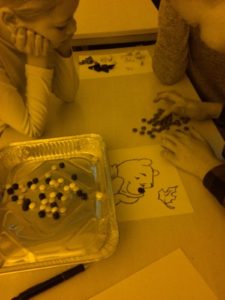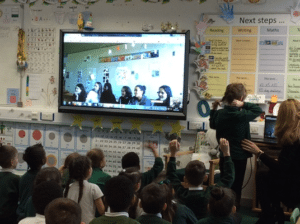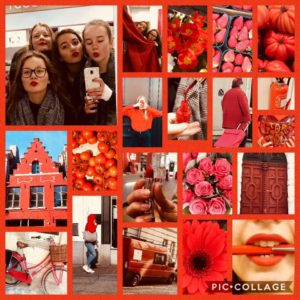Welcome to Unit 1 Seeing STEAM: What if one of our senses changed?
On this page, we will review some key resources from the Seeing STEAM team on the theme of colours and our senses, which we hope will give you inspiration to plan a relevant lesson with your own learners.
After you have reviewed these materials click on Mark Complete at the bottom of this page to continue.
Case study and lesson plan
Idea to Explore
What if we could see colours differently?
Introductory video
Methodology
The sections below – Discover, Define, Develop and Deliver – align to the design thinking model:

Discover
Trigger:
Firstly, we read and talked about the story “The day the crayons quit”by Drew Daywalt. The story was used as a trigger to make the pupils interested and curious.
Trigger 2:
Next, the pupils were introduced to Niel Harbisson who has an antenna implanted in his skull that allows him to hear colours.
Define
In the defining phase, we introduced the pupils to the science of light and colours.
We darkened the classroom, so no daylight entered the room. Then three big sodium lamps were heated. Consequently, all colours disappeared and only grey nuances could be seen.
In this light, the pupils were to do different tasks in small groups:
- The pupils looked at four food items, such as beetroot, carrots, bread and bell pepper. Firstly, the students should guess what the food items were and finally, they could taste and see if they were right.
- The pupils had a plate with several M&Ms, the task was to separate all the red M&Ms from the other colours. The students realised it was difficult to distinguish between red and green M&Ms.
- The pupils should colour a drawing of Winnie the Pooh using the right colours.

Afterwards, the class discussed what happens to our senses when we couldn’t see the right colours. Instead, our other senses, such as the olfactory sense, were enhanced. They also had to be creative to figure out which colours they were using.
Develop
To develop the project, we had a Skype session with the other countries. Before the Skype session, we created a small game for the other countries. In groups of five people, the pupils should find five sounds that symbolize a colour. (E.g. the sound of the sea symbolizes the colour blue). Since they had to create five sounds, they should prioritise the level of difficulty, when record the sounds. The app Keezy was used.
The other countries had to guess the colour. If they guessed it from the first sound clue, they got 5 points, after two sound clues, they got 4 points etc.

The purpose of doing this activity was to show the pupils that if a sense disappears, the other senses will be enhanced.
Having worked with different aspect of colours during the day, the pupils took photos of colours in their everyday surroundings and collected them in the app Pic Collage.
The next step of the process was to use the photos from the other countries to investigate and manipulate the colours of the photos through apps such as Rollworld and Dash of Color, and in that way learn about the other countries as well as how colours affect our perceptions of objects and cultures.

Deliver
In the end, the photos were further manipulated using editing tools in WeVideo and made into art videos that interpreted what would happen if we could see colours differently.
International Collaboration
The international collaboration created interdependence through exchanging quizzes connecting sounds and colours in Skype sessions and swapping photos that were manipulated and finally made into art videos as an interpretation of what would happen if we could see colours differently.
Reflections and Questions
Here are some ideas for developing this project further.
In the discovery phase, you could spend more time on introducing science related to our senses. For example, pupils could have a first-hand experience of bending light by investigating prisms. Music and sound could be explored in relation to colour by playing music while the room is grey.
In the Deliver phase, the pupils created videos with the pictures they received. These could be developed to explain concepts that pupils have investigated.
Mathematics could be integrated into the project by graphing the results of taste tests or an eye colour survey. Younger children could sort objects by their associations with different senses or carry out food fraction activities based on reading the book Eating Fractions by Bruce McMillan.
Resources Needed
- Sodium lamps, M&Ms, carrots, bread, pepper, beetroot
- iPads or Androids with the apps Rollworld, Dash of Color, Be Funky, for manipulating colours and photos, PicCollage for making photo collages, and Keezy for connecting sounds with colours. A free Android app similar to Keezy is Beatbox.
- WeVideo, iMovie, or a similar video editing tool.
STEM to STEAM analysis
Science: Introduce pupils to the science of colours and light.
Technology: Use apps to manipulate photos and sounds, to connect sounds with colours and to edit videos.
Engineering: The Ted Talk from Neil Harbisson demonstrated how you can change the way you experience colours through an implant. It may be possible to organise a demonstration of an Emotiv headset that enables you to experience thought control through technology.
Art: Produce art videos in Wevideo on the basis of the photos from the other countries. Use black and white photos and manipulate with colours and add sounds to create different emotions and artistic expressions. Create compositions on a sound board using Keezy based on sounds associated with colours, and then use coloured squares as a form of musical notation linked to the app.
Mathematics: Ideas for extending the theme into mathematics include data handling based on surveys connected to the senses.
Padlet – Ideas
Below is a Padlet of examples to help you to think about how you could develop this theme in your own teaching context.
You can open the Padlet in a new tab if you prefer: https://padlet.com/helencaldwell/whatifoneofoursenseschanged
After you have reviewed these materials click on Mark Complete at the bottom of this page to continue.
